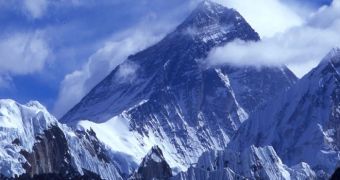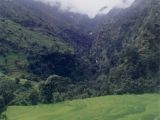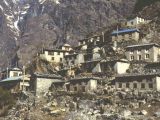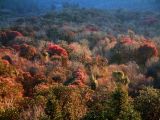If you look on a world map, you will see a huge brown Arch, 2,700 km (1,700 mi) long, stretching from Indus to Brahmaputra, and 250-500 km (140-280 mi) wide crossing the Asian continent.
This is Himalaya mountain chain. It is also called "the Roof of the World" as here are located the 14 highest peaks in the world, all over 8,000 m (26,700 ft). Over 170 peaks are over 7,000 m (23,300 ft) and countless over 6,000 m (20,000 ft)!
The most important part of Himalaya is in Nepal: 9 of the 14 highest peaks are here and 50 of those over 7,000 m.
The highest is Everest (after its British discoverer in the XIX th century) or Chomolungma ("the mother goddess of the mountains" in Tibetan), the "Top of the World". Its last measurement made in 1955 established an altitude of 8,848 m (29, 490 ft) (more or less 2.44 m or 8 ft).
Himalaya represents a barrier in front of the monsoon, that's why a great part of Central Asia is dry. But the southern slope of Himalaya presents rich rainfalls and snowfalls.
At the highest altitudes, Himalaya has glaciers, some over 30 km (18 mi) long.
There are three sectors in Himalaya, with different climates and vegetation.
The "Terai" ("moist land") is a belt of marshy grasslands, savannas and jungles at the base of the Himalaya in India, Nepal and Bhutan. Much of the Terai has been converted to farmland, but in Nepal's National Parks we can still find protected elephants, tigers and rhinoceros. This is the most densely inhabited area of the Himalaya. The main culture is rice and in drier areas - wheat.
Upper is the Low Himalaya, an area of hills and middle mountains up to 3,000 m (10,000 ft) tall. They are covered by deciduous forests with oriental chestnuts, birches and blue and silver pines. At 3,000 m the vegetation is formed by large Rhododendron trees, and between them grow various orchids, ferns and mosses.
Upward, the vegetation gets thinner, the ground being covered by pastures and over 4,000 m glacial lakes appear and the grass is sparse, located between rocks. At over 5,500 m (18,300 ft) begins the zone of eternal ice and snow, the High Himalaya (Proper Himalaya) and the air is very rarefied.
At 3,000-3,500 m, people can cultivate potato, barley, buckwheat and rarely corn. The small patches of arable land that can be extorted from the mountain are cultivated with the hoe or a yak driven plow. At this altitude, the population practices just transhumant husbandry and in the summer shepherds get to the 5,000 m. The most important animal is the yak, extremely resistant to cold and not pretentious about food. It is employed for plowing, transport (it is slow but hardy), milk (for butter and cheese) and hair (used for making fabric for clothing and tends.
With the increasing altitude the human settlements get rarer and more isolated. Families go out of their village just a few times per year to sell or barter their products in order to get necessary goods. These journeys can last for weeks.
In Nepal, at over 3,000 m, live the Sherpa people (related to the Tibetans). They build wooden houses, in the basement of which the animals live while in the upper level live the people: this way, the heat produced by the animals, which rises, also heats the human inhabited section of the house.
For the mountaineers, Sherpas are an excellent helping hand for carrying the equipment to the high altitudes, as these people are well-adapted to the conditions of the high mountain.
The main food of this people is butter tea (made of tea leaves, yak butter and salt) with tsampa (local barley or wheat bread).
The first European to cross the Himalayas was the English Samuel Turner in 1800. Through Bhutan he reached Tibet in front of a mission. In the XIX th century the British started the topographic research of the Himalaya.
The first conquest of the Everest took place on May, 29, 1953 when the New Zealand mountaineer Edmund Hillary and his Sherpa guide Tenzing Norgay after a though fight with the cold, snow, ice and rarefied oxygen (using oxygen masks) managed to defeat the mighty Himalaya.
Till 1970, only 28 mountaineers had climbed the Everest, while in 2004 their number had risen to 2,238 (1,148 since 1998) and 186 people died trying to do it.

 14 DAY TRIAL //
14 DAY TRIAL // 


